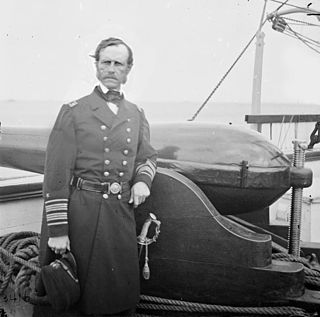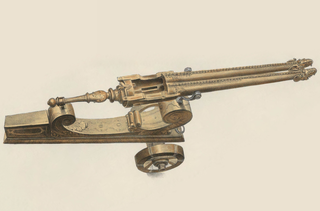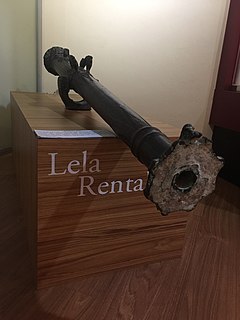
Artillery is a class of heavy military ranged weapons built to launch munitions far beyond the range and power of infantry firearms. Early artillery development focused on the ability to breach defensive walls and fortifications during sieges, and led to heavy, fairly immobile siege engines. As technology improved, lighter, more mobile field artillery cannons developed for battlefield use. This development continues today; modern self-propelled artillery vehicles are highly mobile weapons of great versatility generally providing the largest share of an army's total firepower.

A cannon is a type of gun classified as artillery that launches a projectile using propellant. In the past, gunpowder was the primary propellant before the invention of smokeless powder during the late 19th century. Cannon vary in caliber, range, mobility, rate of fire, angle of fire, and firepower; different forms of cannon combine and balance these attributes in varying degrees, depending on their intended use on the battlefield. The word cannon is derived from several languages, in which the original definition can usually be translated as tube, cane, or reed. In the modern era, the term cannon has fallen into decline, replaced by guns or artillery if not a more specific term such as howitzer or mortar, except for high calibre automatic weapons firing bigger rounds than machine guns, called autocannons.

A breechloader is a firearm in which the user loads the ammunition via the rear (breech) end of its barrel, as opposed to a muzzleloader, which loads ammunition via the front (muzzle) end.

A rifled breech loader (RBL) is an artillery piece which, unlike the smoothbore cannon and rifled muzzle loader (RML) which preceded it, has rifling in the barrel and is loaded from the breech at the rear of the gun.

The Rodman gun is any of a series of American Civil War–era columbiads designed by Union artilleryman Thomas Jackson Rodman (1815–1871). The guns were designed to fire both shot and shell. These heavy guns were intended to be mounted in seacoast fortifications. They were built in 8-inch, 10-inch, 13-inch, 15-inch, and 20-inch bore. Other than size, the guns were all nearly identical in design, with a curving bottle shape, large flat cascabels with ratchets or sockets for the elevating mechanism. Rodman guns were true guns that did not have a howitzer-like powder chamber, as did many earlier columbiads. Rodman guns differed from all previous artillery because they were hollow cast, a new technology that Rodman developed that resulted in cast-iron guns that were much stronger than their predecessors.

Dahlgren guns were muzzle-loading naval artillery designed by Rear Admiral John A. Dahlgren USN, mostly used in the period of the American Civil War. Dahlgren's design philosophy evolved from an accidental explosion in 1849 of a 32-pounder being tested for accuracy, killing a gunner. He believed a safer, more powerful naval cannon could be designed using more scientific design criteria. Dahlgren guns were designed with a smooth curved shape, equalizing strain and concentrating more weight of metal in the gun breech where the greatest pressure of expanding propellant gases needed to be met to keep the gun from bursting. Because of their rounded contours, Dahlgren guns were nicknamed "soda bottles", a shape which became their most identifiable characteristic.

Naval artillery is artillery mounted on a warship, originally used only for naval warfare, later also for shore bombardment and for anti-aircraft use. The term generally refers to tube-launched projectile-firing weapons and excludes self-propelled projectiles like torpedoes, rockets, and missiles and those simply dropped overboard like depth charges and naval mines.
A gun carriage is a frame and mount that supports the gun barrel of an artillery piece, allowing it to be manoeuvred and fired.
A muzzle-loading rifle is a muzzle-loaded small arm or artillery piece that has a rifled barrel rather than a smoothbore. The term "rifled muzzle loader" typically is used to describe a type of artillery piece, although it is technically accurate for small arms as well. A shoulder arm is typically just called a "rifle", as almost all small arms were rifled by the time breechloading became prevalent. Muzzle and breechloading artillery served together for several decades, making a clear distinction more important. In the case of artillery, the abbreviation "RML" is often prefixed to the guns designation; a Rifled breech loader would be "RBL", or often just "BL", since smoothbore breechloading artillery is almost nonexistent. A muzzle loading weapon is loaded through the muzzle, or front of the barrel. This is the opposite of a breech-loading weapon or rifled breechloader (RBL), which is loaded from the breech-end of the barrel. The rifling grooves cut on the inside of the barrel cause the projectile to spin rapidly in flight, giving it greater stability and hence range and accuracy than smoothbore guns. Hand held rifles were well-developed by the 1740s. A popularly recognizable form of the "muzzleloader" is the Kentucky Rifle, which was actually developed in Pennsylvania. The American Longrifle evolved from the German "Jäger" rifle.

An Armstrong gun was a uniquely designed type of rifled breech-loading field and heavy gun designed by Sir William Armstrong and manufactured in England beginning in 1855 by the Elswick Ordnance Company and the Royal Arsenal at Woolwich. Such guns involved a built-up gun construction system of a wrought-iron tube surrounded by multiple wrought-iron strengthening coils shrunk over the inner tube to keep it under compression.

Charles Ragon de Bange (1833–1914) was a French artillery officer and Polytechnician. He invented the first effective obturator system for breech-loading artillery, which remains in use. He also designed a system of field guns of various calibers which served the French Army well into World War I: the Système de Bange.

The Reffye 75mm cannon was a French artillery piece of the 19th century, developed by the French artillery General Jean-Baptiste Verchère de Reffye, superintendent of the works at Meudon. The weapon was adopted by the French Army from 1873. It was a 75 mm rifled breech-loading cannon, equipped with a breech screw, initially made of bronze.

A Pierrier à boîte was an early type of small wrought iron cannon developed in the early 15th century, and a type of breech-loading swivel gun. It was part of the artillery of France in the Middle Ages, and the artillery of the Middle Ages in general. Perrier is the historical term in English for such weapons, literally a stone thrower.

Artillery in Japan was first used during the Sengoku period in the 16th century; and its use has continued to develop.

A breech-loading swivel gun was a particular type of swivel gun and a small breech-loading cannon invented in the 14th century. It was equipped with a swivel for easy rotation and was loaded by inserting a mug-shaped device called a chamber, filled with gunpowder and projectiles. It had a high rate of fire, as several chambers could be prepared in advance and quickly fired in succession and was especially effective in anti-personnel roles. It was used for centuries by many countries of Europe, Asia and Africa.

The Cetbang was a type of cannon produced and used by the Majapahit Empire (1293–1527) and other kingdoms in the Indonesian archipelago. The cetbang is a breech-loading cannon, it is different from typical European and Middle Eastern cannons, which are usually muzzleloader. In the Sekar inscription it states that the main production foundries of cetbang were in Rajakwesi, Bojonegoro, whereas the black powder was produced in Swatantra Biluluk (Lamongan). Several examples survive and are exhibited as tourist attractions or in museums.

The Cannone da 149 G later known as the Cannone da 149/23 was an Italian fortress gun and siege gun which served with Italy during the Italo-Turkish War and World War I. Captured guns may have been used by Austria-Hungary.

The 9 cm Kanone C/79 was a fortress and siege gun developed after the Franco-Prussian War and used by Germany before and during World War I.

The 8 cm Kanone C/80 was a field gun developed during the late 1800s by Krupp for the export market. It saw action in numerous regional conflicts as well as World War I.

Lela or lila is a type of Malay cannon, used widely in the Nusantara archipelago. They are similar to a lantaka but longer and had larger bore. Lela can be configured as swivel gun, fixed gun, or mounted in a gun carriage. It is the equivalent of European falcon and falconet.
















